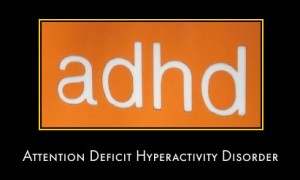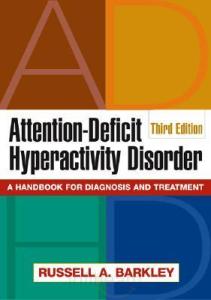|
Attention Deficit Hyperactivity Disorder (Page 1)Thinking About Becoming A Psychology Student? Find A Psychology School Near YouAttention Deficit Hyperactivity Disorder
(Photo Credit: Kelly Smith) The following information is provided courtesy of The National Institute of mental Health. What is ADHD?Attention deficit hyperactivity disorder (ADHD) is one of the most common childhood disorders and can continue through adolescence and adulthood. Symptoms include difficulty staying focused and paying attention, difficulty controlling behavior, and hyperactivity (over-activity). ADHD has three subtypes: 1. Predominantly Hyperactive-Impulsive Most symptoms (six or more) are in the hyperactivity-impulsivity categories. Fewer than six symptoms of inattention are present, although inattention may still be present to some degree. 2. Predominantly Inattentive The majority of symptoms (six or more) are in the inattention category and fewer than six symptoms of hyperactivity-impulsivity are present, although hyperactivity-impulsivity may still be present to some degree. Children with this subtype are less likely to act out or have difficulties getting along with other children. They may sit quietly, but they are not paying attention to what they are doing. Therefore, the child may be overlooked, and parents and teachers may not notice that he or she has ADHD. Combined Hyperactive-Impulsive & Inattentive Six or more symptoms of inattention and six or more symptoms of hyperactivity-impulsivity are present. Most children have the combined type of ADHD. Treatments can relieve many of the disorder's symptoms, but there is no cure. With treatment, most people with ADHD can be successful in school and lead productive lives. Researchers are developing more effective treatments and interventions, and using new tools such as brain imaging, to better understand ADHD and to find more effective ways to treat and prevent it. ADHD Symptoms in ChildrenInattention, hyperactivity, and impulsivity are the key behaviors of ADHD. It is normal for all children to be inattentive, hyperactive, or impulsive sometimes, but for children with ADHD, these behaviors are more severe and occur more often. To be diagnosed with the disorder, a child must have symptoms for 6 or more months and to a degree that is greater than other children of the same age. Children who have symptoms of inattention may: Be easily distracted, miss details, forget things, and frequently switch from one activity to another. Have difficulty focusing on one thing. Become bored with a task after only a few minutes, unless they are doing something enjoyable. Have difficulty focusing attention on organizing and completing a task or learning something new. Have trouble completing or turning in homework assignments, often losing things (e.g., pencils, toys, assignments) needed to complete tasks or activities. Not seem to listen when spoken to. Daydream, become easily confused, and move slowly. Have difficulty processing information as quickly and accurately as others. Struggle to follow instructions. Children who have symptoms of hyperactivity may: Fidget and squirm in their seats. Talk nonstop. Dash around, touching or playing with anything and everything in sight. Have trouble sitting still during dinner, school, and story time. Be constantly in motion. Have difficulty doing quiet tasks or activities. Children who have symptoms of impulsivity may: Be very impatient. Blurt out inappropriate comments, show their emotions without restraint, and act without regard for consequences. Have difficulty waiting for things they want or waiting their turns in games. Often interrupt conversations or others' activities. ADHD Can Be Mistaken for Other Problems Parents and teachers can miss the fact that children with symptoms of inattention have the disorder because they are often quiet and less likely to act out. They may sit quietly, seeming to work, but they are often not paying attention to what they are doing. They may get along well with other children, compared with those with the other subtypes, who tend to have social problems. But children with the inattentive kind of ADHD are not the only ones whose disorders can be missed. For example, adults may think that children with the hyperactive and impulsive subtypes just have emotional or disciplinary problems. ADHD in AdultsSome children with ADHD continue to have it as adults. And many adults who have the disorder don't know it. They may feel that it is impossible to get organized, stick to a job, or remember and keep appointments. Daily tasks such as getting up in the morning, preparing to leave the house for work, arriving at work on time, and being productive on the job can be especially challenging for adults with ADHD. These adults may have a history of failure at school, problems at work, or difficult or failed relationships. Many have had multiple traffic accidents. Like teens, adults with ADHD may seem restless and may try to do several things at once, most of them unsuccessfully. They also tend to prefer "quick fixes," rather than taking the steps needed to achieve greater rewards. What Causes ADHD?Scientists are not sure what causes ADHD, although many studies suggest that genes play a large role. Like many other illnesses, ADHD probably results from a combination of factors. In addition to genetics, researchers are looking at possible environmental factors, and are studying how brain injuries, nutrition, and the social environment might contribute to ADHD. Genes: Inherited from our parents, genes are the "blueprints" for who we are. Results from several international studies of twins show that ADHD often runs in families. Researchers are looking at several genes that may make people more likely to develop the disorder.2,3 Knowing the genes involved may one day help researchers prevent the disorder before symptoms develop. Learning about specific genes could also lead to better treatments. Children with ADHD who carry a particular version of a certain gene have thinner brain tissue in the areas of the brain associated with attention. This NIMH research showed that the difference was not permanent, however, and as children with this gene grew up, the brain developed to a normal level of thickness. Their ADHD symptoms also improved.4 Environmental factors: Studies suggest a potential link between cigarette smoking and alcohol use during pregnancy and ADHD in children.5,6 In addition, preschoolers who are exposed to high levels of lead, which can sometimes be found in plumbing fixtures or paint in old buildings, may have a higher risk of developing ADHD.7 Brain injuries: Children who have suffered a brain injury may show some behaviors similar to those of ADHD. However, only a small percentage of children with ADHD have suffered a traumatic brain injury. Sugar: The idea that refined sugar causes ADHD or makes symptoms worse is popular, but more research discounts this theory than supports it. In one study, researchers gave children foods containing either sugar or a sugar substitute every other day. The children who received sugar showed no different behavior or learning capabilities than those who received the sugar substitute.8 Another study in which children were given higher than average amounts of sugar or sugar substitutes showed similar results. In another study, children who were considered sugar-sensitive by their mothers were given the sugar substitute aspartame, also known as Nutrasweet. Although all the children got aspartame, half their mothers were told their children were given sugar, and the other half were told their children were given aspartame. The mothers who thought their children had gotten sugar rated them as more hyperactive than the other children and were more critical of their behavior, compared to mothers who thought their children received aspartame.10 Food additives: Recent British research indicates a possible link between consumption of certain food additives like artificial colors or preservatives, and an increase in activity. Research is under way to confirm the findings and to learn more about how food additives may affect hyperactivity. More InformationSee following link for information on how ADHD is diagnosed and treated. Attention Deficit Hyperactivity Disorder: Page 2 Essential Attention Deficit Hyperactivity Disorder ReadingAttention Deficit Hyperactivity Disorder, Third Edition: A Handbook for Diagnosis and Treatment by Russell A. Barkley PhD
Book Description Now in a revised and expanded third edition, this handbook presents the latest knowledge on the nature, diagnosis, assessment, and treatment of Attention-Deficit/Hyperactivity Disorder (ADHD). Provided are state-of-the-art guidelines for understanding and managing the challenges ADHD poses to children, adolescents, and adults in a range of settings. Featuring a new chapter on combined therapies, this book is the most comprehensive, authoritative, and up-to-date work in the field. See following link for more details: Attention-Deficit Hyperactivity Disorder, Third Edition: A Handbook for Diagnosis and Treatment Classic Articles All Psychology Students Should Read
This special Kindle collection consists of the most influential, infamous and iconic research articles ever published in the history of psychology. See following link for full details. The Psychology Classics Kindle Collection Go Back To The Main Mental Health Page Go From Attention Deficit Hyperactivity Disorder Back To The Home Page
|







